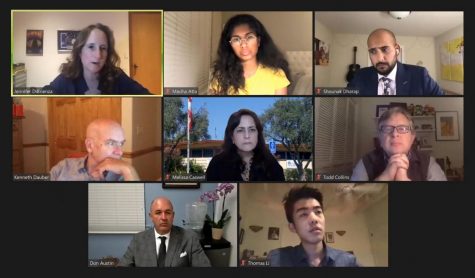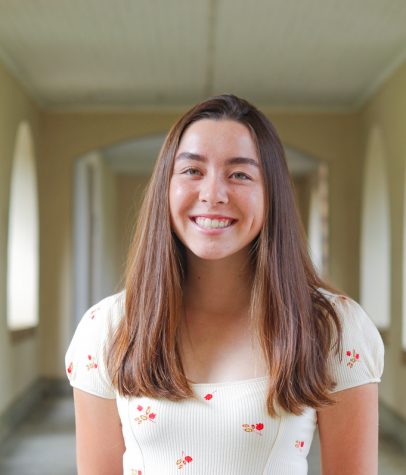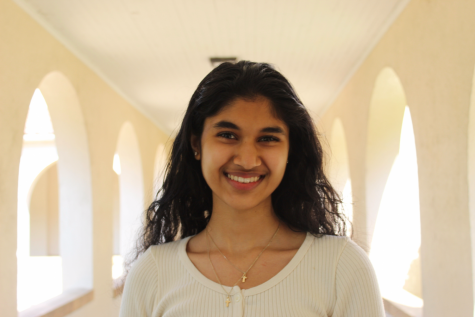Board unanimously approves reopening plan
October 2, 2020

Despite outcry from teachers hesitant to return to in-person instruction, the Palo Alto Board of Education voted unanimously Tuesday night to approve the plan for the hybrid return of elementary students starting mid-October.
Many of the elementary teachers, teacher specialists and special education teachers who spoke during public comment at last week’s board meeting returned Tuesday to underscore concerns over safety and ventilation, effectiveness of asynchronous learning in the hybrid model and disruption of classroom communities. The Board, however, moved ahead with the proposed plan.
“We haven’t said no to anything,” Superintendent Don Austin said. “We have agreement on every single element that’s been brought forward with one minor exception, which I think we’ll work through. If the answer is nothing is going to change that number [of teachers ready to return], then we don’t have anywhere else to go.”
According to the action item listed on the board agenda, the plan to return is four-fold: elementary students can begin a staggered return to in-person instruction, elementary families can choose between adopting the hybrid model or remaining in distance learning, secondary students will continued distance learning, and all students can participate in various in-person activities at their sites.
All five board members approved the plan, while both student board members, seniors Thomas Li from Gunn High School and Medha Atla from Palo Alto High School, voted in opposition. Though the student vote is preferential, meaning it does not contribute to the outcome of the vote, both representatives shared thoughts on why they believed the October in-person return plan to be too hasty.
“I understand that nothing is comparable to the in-person learning education experience, especially for an elementary school student,” Atla said in her response. “But on the same note, nothing is comparable to staff and teachers that we have in this district … we need to hear their voice, and they clearly do not feel safe for a plethora of reasons for returning on the proposed date.”
Li emphasized the need for clear safety protocol before reopening, as topics including outdoor teaching, air quality, and cross-pollination among classes and campuses are still undergoing discussion.
“I hope that we’re able to come back with a more solid plan and just have these details figured out so that we decrease the chance of transmission even more,” Li said.
Board member Ken Dauber said PAUSD aims to fulfill their “fundamental mission” and uplift students to reach their full potential under current circumstances by reopening schools.
“Some students are thriving with distance learning,” Dauber said. “But many students are not thriving. They struggle with attention, they struggle with distractions, they struggle with lack of social contact, they struggle with lack of resources at home. Teaching every child … means doing our best to get them back to school.”
Parents of kindergarten and first-grade students, the first group scheduled to come back, were asked to decide whether to opt-in to the hybrid model by Wednesday night. Families who did not choose an option would default to distance learning, the Board determined. Later, the Board suggested that there may be an opportunity for families to reevaluate their choices in January.
“It’s possible that if they picked distance learning, it’s for [all] 30 weeks [of the school year],” Board member Jennifer Dibrienza said. “And it’s possible that if it’s distance learning, there will be a chance in January to come back in-person.”
Austin indicated in a tweet Thursday that about 625 transitional kindergarten to first-grade students have opted in to return on Oct. 12.
Safety concerns
At the start of the meeting, Monika Roy, a county health official, spoke on outdoor in-person learning.
“In general, we recommend as much as possible moving things outdoors,” Roy said. “Providing as much instruction outdoors, if there’s activities in general being outdoors, is going to be the safer option.”
While Austin agreed that outdoor activities conducted according to teachers’ comfort would be a “good thing,” he cautioned that mandating outdoor classes could be problematic, especially on bad air days.
“It would have massive negotiation implications as far as working conditions,” Austin said. “Now, going outside as a teacher discretion is absolutely something that we think is a good thing.”
Teri Baldwin, president of the Palo Alto Educators Association, shared the results of a newly issued teacher’s union survey of staff members and encapsulated growing anxiety among teachers.
According to the survey, 90% of elementary teachers and 92% of secondary teachers reported discomfort with resuming in-person instruction anytime between September and November. Baldwin also reported that 53% of teachers said they may feel comfortable coming back in January after reassessing the county’s positivity rate and 37% said they would prefer to maintain distance learning for the rest of the year.
Ventilation — particularly in classrooms without windows, or with windows that are unable to be opened — is a prime topic of safety concern among teachers. According to Baldwin, personal protective equipment is arriving, but certain items like face shields with neck cloths have not yet been made available to teachers. Likewise, hand-washing stations are yet to be added classrooms lacking sinks.
“We’re starting in less than two weeks,” Baldwin said. “Questions like these should be able to be answered … It feels like we’re rushing to open to meet a self-imposed goal day of October 12 when many other large unified districts are committing to distance learning until January when the situation can be reassessed.”
In addition to the original reopening plan, the Board moved to compile a teacher collaborative group to provide updates on teacher sentiments as reopening occurs and to create a checklist for every classroom to ensure safety guideline compliance before students are put into classrooms.
According to Meb Steiner, president of California School Employees Association Palo Alto Chapter 301 and a PAUSD special education instructional aide, post-secondary programs and moderate to severe special education FUTURES students have already returned in-person. Plans to reduce contact between staff and various students still appear unclear, though, and erring on the side of caution is best, Steiner said.
“We are still not clear on how are we minimizing the cross-pollination of our specialists as they support our special ed kids,” Steiner said. “We need to hang on to our people. We need to support them. And I urge us to do that. I urge us to slow down implementation, as many other districts in the region have.”
The district is looking into a partnership with Stanford Health Care for bi-weekly COVID-19 testing for employees, though not yet for students as neither the California nor County Departments of Public Health have issued student testing guidelines.
“If the recommendations we follow are sound from the county, and we’re being assured they are, to a certain degree, we have to trust them,” Board member Shounak Dharap said. “[If] our implementation of those is sound, then I expect … any community spread of COVID will be mitigated by our processes within the school system.”
Asynchronous learning concerns
With the implementation of a hybrid schedule for elementary students consisting of half the week in-person and the other half asynchronous time, some parents fear their young children won’t fare well learning on their own.
Asynchronous learning was not optimal for students in the spring, Palo Verde Elementary and Jane Lathrop Stanford Middle School parent Rich Matta said. Now in the fall, synchronous learning has proved to be a much better model for young students.
“The teachers take attendance, give instruction and help keep our kids focused full time during school hours, something that working parents like us simply cannot do,” Matta said. “A hybrid model contains a massive, unsupervised, utterly unproductive asynchronous component.”
Li echoed the concern over asynchronous time as one reason he could not vote in favor of the plan.
“Are we really expecting elementary students to diligently work for 260 minutes offline without guidance from a teacher?” Li asked. “If that’s the case, then the work is really going to fall on parents who are just going to put more work into supporting their students while they’re offline, and that causes them to be more overworked than they already are.”
Disruption of classroom communities
Parents at the last two board meetings aired worries that the hybrid model would disrupt elementary classroom communities and separate students from their teachers. Addressing a slew of questions over the implementation of the hybrid model, Austin said it is possible certain students will be given a new teacher — or school — for in-person learning due to limited class size and teachers available in-person each day, though the district will attempt to assign as few switches as possible.
“There’s going to be a potential change of class, we’re going to minimize that,” Austin said. “And a delay until January doesn’t make that better, I would argue it makes it harder.”
Many parents and teachers strongly cautioned the Board against moving too quickly, with many repeatedly echoing the sentiment that the Board ought to prioritize safety over reopening speed.
“Elementary education is not the appropriate arena for being first [to reopen],” Nixon elementary teacher Katie Ellenberger said. “We should not be first to break apart classroom communities … We should be first to keep our school communities together [students with their current teachers] in a way that fosters their individuality. I hope the Board and district can put their communities first.”
“The staff recommendation is our best attempt to mirror what we were asked to do by the Board of Education,” Austin said in response. “The return of the youngest learners was a top priority.”



